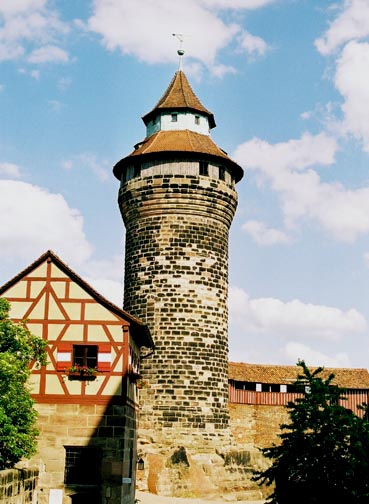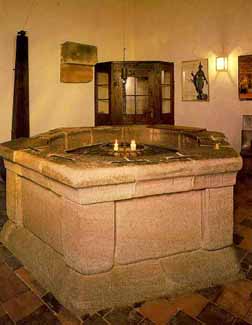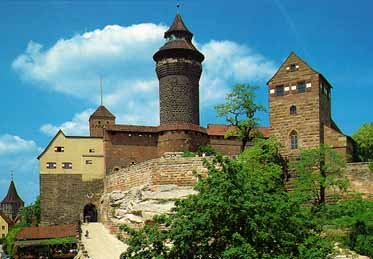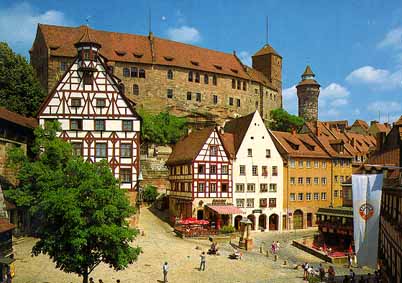The castle in Nürnberg,
Germany

Aerial view of Nürnberg
shows the Kaiserburg
The photograph above shows an aerial
view of Nürnberg with the Kaiserburg (Emperor's castle)
on the left and the Sinwellturm (Sinwell Tower) in the center
of the picture. From the Kaiserburg, there is a spectacular view
of the whole city of Nürnberg with its beautiful red roof-tops.
It was the custom for the Germanic people
in medieval Europe to set up a castle, around which a town would
develop. Nürnberg was founded in the 11th century as the
residence of Kaiser (Emperor) Heinrich III and the city that
quickly followed became an important trade center. In 1332, Nürnberg
was declared an imperial city, or a city state, by King Ludwig
the Bavarian; it remained an imperial free city, with its local
government answering only to the King, until 1806 when it was
incorporated into the Kingdom of Bavaria, now the German state
of Bavaria, after Napoleon's conquest.
Nürnberg was the place where the
imperial Reichstag (Parliament or Congress) met until 1543. It
was also the unofficial capital of the Holy Roman Empire, which
began when the Pope of the Roman Catholic Church crowned the
first Emperor on Christmas day in the year 800 AD. The first
Holy Roman Emperor was from the German tribe called the Franks;
to most of the world, he is known as Charlemagne or Charles the
Great, but he has always been known as Karl der Grosse to the
Germans. He was chosen as the Emperor by the Pope because he
was Roman Catholic at a time when there were several other Christian
sects in Europe.
The original city of Nürnberg was
established inside a defensive brick wall guarded by 46 fortified
towers, surrounded by a moat filled with water and then another
outside wall. There were five main gates into the city, four
of which are still standing, including the Königstor (Kings's
Gate), which is located across from the main railroad station
and is the first piece of Nürnberg history that most tourists
see.
The photograph below shows a view of
the Sinwell Tower that is shown in the center of the aerial view
at the top of this page. To the left of the Sinwell Tower, in
the center of the photo below, is a small half-timbered building
which houses the Tiefer Brunnen (Deep Well).

Sinwell Tower with
Deep Well inside the small building

Deep Well inside building
at Kaiserburg
The Deep Well, shown in the photo above,
is the last thing on the hour-long tour of the Kaiserburg. After
that, a climb up the steep steps to the top of the Sinwell Tower
is optional. In the picture above, you can see two candles inside
the well. This is part of a demonstration in which candles are
lowered into the well and then pulled up again, still burning,
which shows that there is oxygen in the well, although it is
very deep. The tour guide drops an object into the well to demonstrate
that it is very deep because it is a long time before the splash
into the water is heard.
The Kaiserburg was built in stages and
there are actually three parts to the castle: the Kaiserburg
(Emperor's castle), the Burggrafenburg (castle of the count)
and the Stadtburg (city castle). After Kaiser Konrad III built
the original Kaiserburg in the 13th century, it was greatly expanded
by the next emperor, Frederick Barbarossa. The next 30 Holy Roman
Emperors spent at least one night, by law, in the unheated castle.

Der Heidenturm (Heiden
Tower) at the Kaiserburg

Another view of the
towers at the Kaiserburg

View of the Kaiserburg
in the background
Nürnberg is famous as the home of
Albrecht Dürer, an artist who lived from 1471 to 1528, and
was the court painter for Kaiser Maximilian I; his house has
been preserved as the best example of a Renaissance house in
Germany. The house where Dürer lived is located very close
to the castle which is shown in the photo above; the Sinwell
Tower is on the right.
Nürnberg was the cultural center
of the German Renaissance and it was also the home of other artists,
but Albrecht Dürer was the most famous of them all. He was
noted for his portrait of Charlemagne which hangs at the Germanishes
National museum and for his representation of the Four Apostles
at the Nürnberg Rathaus (City hall). Besides paintings,
Dürer also did copper and iron engraving and wood block
printing.
|